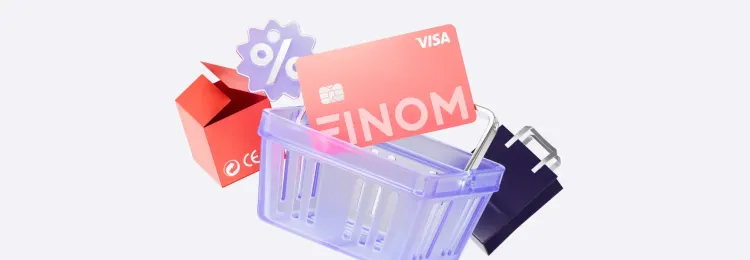If you wish to go cashless, read our virtual card guide and learn how to use your smartphone to make quick and efficient payments.
You've undoubtedly heard of virtual cards, but maybe you're not sure what they are or how they might benefit your business or personal life. If you’re ready to get a deeper understanding, check out this guide to virtual cards. We’ll cover their types, acceptable applications, and how you may obtain your online virtual card from Finom's simple process.
What Is a Virtual Card?
A virtual debit card is similar to a traditional credit card, as it has randomly generated 16 digits that are randomly generated, a CVV, and the name of the card issuer. Virtual cards are connected to an associated bank account and may be accessed through your smartphone from anywhere. Virtual credit cards are simple to use online, but they can also be used offline. Just keep them in your digital wallet and use them at the checkout for a contactless transaction.
Virtual cards are a viable alternative to regular cards, as they allow you to make online payments without utilizing your credit card's original data, making data theft almost impossible. Thus, they offer far more security than conventional cards.
Discover our business accountTypes of Virtual Cards
A virtual card may be either a credit or debit card.
When you apply for a credit card, you will be given a unique virtual credit card number to be used for online purchases. This number is linked to your primary credit account, but it will have no effect on your credit score. There are several credit card companies that will issue you a virtual credit card; however, certain vendors do not accept payments in this format.
A virtual debit card is also available. This allows you to make payments without the requirement for a physical credit card. It's entirely digital, and you may do any online shopping as usual. If you desire a virtual debit card, the supplier will supply you with card details such as the PIN and virtual card number. If you’d like, you can get a new card number after each purchase. Top up the balance or leave it the same - it’s up to you. You can also set a spending limit by restricting where and how your money is spent.
How Does a Virtual Card Work?
A virtual card allows you to pay online and through an app, offering you the experience of a real card but with a higher level of security. You will not have to disclose your credit or debit card information.
Are Virtual Cards Valid For A Single Use Only?
Virtual credit or debit card numbers can usually be used one time. If they are not utilized once they've been produced, they may expire after a certain period of time. You can set an expiration date of up to 1 year.
After you use the number to make a purchase, any remaining amount is refunded back to your original account. Cloning the cards is extremely difficult. You can produce virtual numbers in certain situations to use for a controlled transaction until they are switched off.
Learn about free invoicing serviceHow to Get a Virtual Card?
A virtual card can be obtained online through a bank or a financial service website (for instance, Finom). If you require a free virtual debit card, you may always obtain one from Finom - the financial solution that integrates a banking company account, invoicing, and accounting software.
You can generate a virtual card along with a physical one by following a few simple steps:
- Log in to your Finom account and choose “My Cards.”
- Here you can order a physical card and a virtual card.
- By continuing the process, you will get to your virtual card.
- Your online virtual card is ready to use.
- Proceed with online purchases as usual. For offline purchases, simply hold it near the reader.
Where to Use Virtual Cards
Any organization that accepts regular card transactions may accept virtual cards as well. This type of virtual payment is also on the rise.
A virtual debit or credit card can be used in the same way as a conventional bank card would. They may be used for in-store cashless transactions as well as shopping online. Some virtual cards can even be used to make ATM withdrawals.
Learn more about FinomHow to Add Funds to A Virtual Card
To top up a virtual credit or debit card, choose how much money to transfer from your bank account or credit card. The amount you specify will be transferred digitally.
When the balance on your virtual credit or debit card is insufficient, you may add more via an online transaction from your bank account. There is no requirement for you to remove funds from your account in order to fund your cards.
Virtual Cards for Businesses
Virtual cards may be issued and transmitted online, allowing businesses to trade immediately without having to wait for a traditional card to be issued. This is excellent for firms that need to move swiftly.
Credit card companies also help prevent scams while making virtual cards quickly freezable. You can lock your card instantly after a transaction, unlock it when you need to make the next payment, and then lock it again. Even if the virtual payment information is captured, the scammer might not be able to use them.
Because virtual cards can’t be misplaced, they are more protected than real cards. Card information is accessible through online or mobile applications. When you use your virtual card to pay, you can see card payments right away, reducing the risk of human error. It saves administrators time that would otherwise be spent going through each confirmation and checking each receipt.
You have the ability to set spending limits on what may be bought with the virtual credit card numbers you produce. You can also save money on transaction fees such as authorizations, payment processing, and reimbursements. Using virtual credit and debit cards can help you expedite your card payments and better manage your expenditures.
Benefits Of Virtual Cards
Virtual cards, as opposed to real cards, contain a layer of security that provides consumers with a safer, more accessible, and far more regulated purchasing experience. You'll appreciate the benefits of virtual cards whether you're a small company owner, a fintech entrepreneur, or a finance professional.
To begin with, obtaining a virtual card is straightforward and quick. An unrivaled benefit, especially given that obtaining and using a standard credit or prepaid card requires at least 7 working days.
Virtual cards are extremely inexpensive; they usually come with a small annual charge or a top-up fee, which varies depending on the institution.
Another significant advantage is related to the spending limit. Because this is a prepaid card, there is no risk of exceeding the budgeted amount.
Finom tips: How to connect my card to Google Pay?
Are Virtual Cards Safe to Use?
Security flaws occur, and some browser extensions keep their consumers' credentials. Physical cards are also susceptible since they can be stolen, lost, or hacked by card readers. Safety is a key concern, particularly for a corporation, because numerous individuals may need to use the same account for a range of transactions. But virtual cards are totally safe to use and widely accepted. A virtual card’s numbers cannot be used to exchange cash or pay by check.
Should You Use Virtual Cards?
Virtual cards safeguard your data and ensure the greatest degree of security for online purchases. They make shopping safer and simpler: instead of depending on your bank, you have complete control over your online purchases. You may select the currency you require, establish a spending limit for the card, and specify the sorts of merchants where the card can be used.
Virtual payment cards simplify the payment process for both customers and subcontractors, and there are captivating advantages for your company.
Finom allows its users to issue Visa cards for German and Italian citizens, as well as Mastercard cards for France.
Forget about card issuance and yearly maintenance costs. You may save up to 50% by using virtual cards for cashback. You can quickly lock or unlock your card and reset its PIN using your smartphone. Set and adjust your monthly spending limit at any moment.
Last articles

Finom plans are changing – what it means for you

The Best CRMs for Small Businesses: How to Find Your Perfect Software

Finom Raises €50M in Series B Funding Led by General Catalyst and Northzone

Passkeys: Powering Finom’s Security Upgrade

Pro Forma Invoice: What It Is and Its Meaning

PO vs. Invoice: What Are the Differences Between These Financial Terms?

Direct Debit: What It Is and What Are the Advantages?


